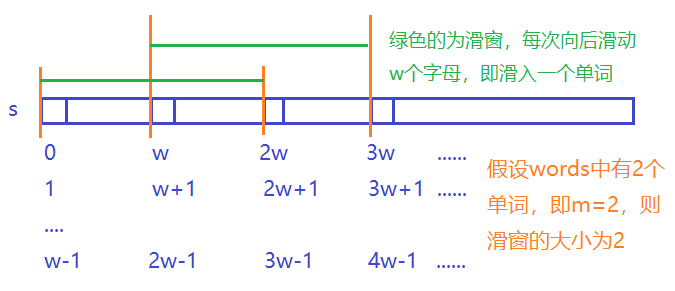分析
-
本题的考点:哈希表、滑动窗口、字符串哈希。
-
首先约定一些常数:
n=s.size(), m=words.size(), w=word[i].size()。哈希表tot记录words中每个单词出现的次数。 -
我们可以枚举由
words组成的子串在s中的起始位置,因为words中的单词长度为w,因此起点位置对w取模,可以分为w个同余类,即0~w-1,如下图,每行是一个同余类:

- 对于每个同余类,即确定了子串的起点,我们采用滑动窗口,滑窗中的单词采用哈希表
wd记录,如果滑窗中元素等于m,则判断滑窗中的单词和words中的单词是否完全相同,如果完全相同,则得到一个答案,滑动窗口向后移动w个字母,然后将这个新单词插入wd中,滑窗最前面的单词需要被删除,下面以模0同余类演示一下滑窗的操作:

-
那么如何确定滑窗
wd中的单词和tot中的单词全部一模一样呢,我们可以使用一个变量cnt记录相同单词的数量,如果一个单词在tot中出现多次,比如出现3次,但是在滑窗中出现4次,但cnt只能将该单词加3次,当cnt == m时,说明窗wd中的单词和tot中的单词一模一样,得到一个答案。 -
每个同余类有$\frac{n}{w}$个单词,每操作一个单词,即向
wd中插入一个单词计算量是$w$,因此每个同余类计算量为$O(\frac{n}{w} \times w)=O(n)$量级的,一共w组,因此总的时间复杂度为$O(n \times w)$的。 -
这里可以对向
wd中插入一个单词进行优化,使得插入的计算量为$O(1)$,从而总体时间复杂度降为$O(n)$。采用的方式是字符串哈希(字符串哈希)。
代码
- C++
class Solution {
public:
typedef unsigned long long ULL;
static const int P = 131;
ULL get(ULL h[], ULL p[], int l, int r) {
return h[r] - h[l - 1] * p[r - l + 1];
}
vector<int> findSubstring(string s, vector<string> &words) {
vector<int> res;
if (words.empty()) return res;
int n = s.size(), m = words.size(), w = words[0].size();
// 求s的字符串哈希结果, 从1开始,即h[1]=s[0], 后面求hash值的时候要加上一个偏移量
ULL h[n + 10], p[n + 10]; // p[i] = 10 ^ i
h[0] = 0, p[0] = 1;
for (int i = 1; i <= n; i++) {
h[i] = h[i - 1] * P + s[i - 1];
p[i] = p[i - 1] * P;
}
// 统计words中每个单词出现的次数
unordered_map<ULL, int> tot;
for (auto &word : words) {
ULL t = 0;
for (auto c : word) t = t * P + c;
tot[t]++;
}
for (int i = 0; i < w; i++) {
unordered_map<ULL, int> wd; // windows的缩写
int cnt = 0;
for (int j = i; j + w - 1 < n; j += w) { // 滑动窗口
// 滑窗为[j-m*w, j)
// 每次滑入[j, j+w-1], 滑出[j-m*w, j-m*w-1]
if (j >= i + m * w) {
// 获取单词s[j - m * w, j - m * w + w - 1]对应的哈希值
ULL hash = get(h, p, j - m * w + 1, j - m * w + w);
wd[hash]--;
if (wd[hash] < tot[hash]) cnt--;
}
// 获取单词s[j, j + w - 1]对应的哈希值
ULL hash = get(h, p, j + 1, j + w);
wd[hash]++;
if (wd[hash] <= tot[hash]) cnt++;
if (cnt == m) res.push_back(j - (m - 1) * w);
}
}
return res;
}
};
- Java
// Java这里不演示使用字符串哈希了
class Solution {
public List<Integer> findSubstring(String s, String[] words) {
List<Integer> res = new ArrayList<>();
if (s.length() == 0) return res;
int n = s.length(), m = words.length, w = words[0].length();
HashMap<String, Integer> tot = new HashMap<>();
for (String word : words) tot.put(word, tot.getOrDefault(word, 0) + 1);
for (int i = 0; i < w; i++) {
HashMap<String, Integer> wd = new HashMap<>();
int cnt = 0;
for (int j = i; j + w - 1 < n; j += w) { // 滑动窗口
// 滑窗为[j-m*w, j)
// 每次滑入[j, j+w), 滑出[j-m*w, j-m*w+w)
if (j >= i + m * w) {
String word = s.substring(j - m * w, j - (m - 1) * w);
wd.put(word, wd.getOrDefault(word, 0) - 1);
if (wd.get(word) < tot.getOrDefault(word, 0)) cnt--;
}
String word = s.substring(j, j + w);
wd.put(word, wd.getOrDefault(word, 0) + 1);
if (wd.get(word) <= tot.getOrDefault(word, 0)) cnt++;
if (cnt == m) res.add(j - (m - 1) * w);
}
}
return res;
}
}
时空复杂度分析
-
时间复杂度:使用字符串哈希:$O(n)$,
n为s的长度。不使用字符串哈希:$O(n \times w)$,n为s的长度,w为word[0]长度。 -
空间复杂度:$O(m)$,
m为数组words的长度。

